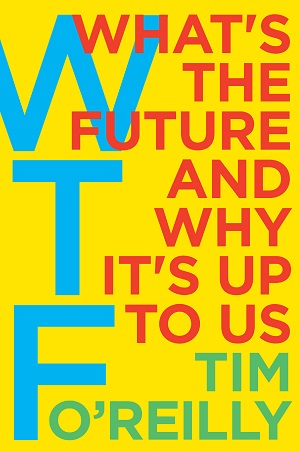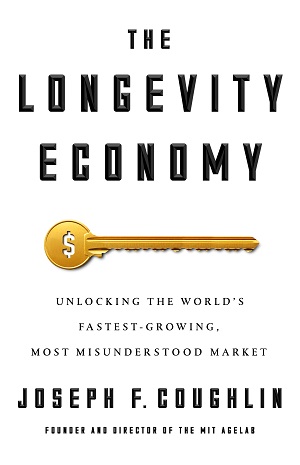 MIT Sloan Management Review, December 14, 2017
MIT Sloan Management Review, December 14, 2017
by Theodore Kinni
These days, scale is a top-of-mind issue among leaders of tech companies. Yet many of these leaders are missing the biggest and most obvious scaling opportunity they’ll ever encounter: old people.
The worldwide population of older adults — people age 65 and up — reached 617 million in 2015 (almost twice the total population of the United States); in the U.S. alone, older adults represent an $8 trillion consumer market. Thanks to longer life expectancies, there will be 1 billion people age 65+ by 2030, and 1.6 billion of them by 2050.
The problem — which Joseph F. Coughlin, director of MIT’s AgeLab and the author of The Longevity Economy, lays out in the excerpt below — is that most tech companies simply don’t get this deep-pocketed, growth market. Worse, because of the relative youthfulness of tech companies, their leaders are not only missing the biggest market they’re likely to see before they become old folks themselves, they’re also overlooking the job candidates who could help them tap it as well.
If your company is seeking scale, read the excerpt here.
Friday, December 15, 2017
Seeking Scale? Think Old
Posted by
Theodore Kinni
at
9:32 AM
1 comments
![]()
Labels: books, change management, competitive intelligence, corporate success, customer experience, innovation, technology
Wednesday, December 13, 2017
How to Break Bad Business Habits
strategy+business, December 13, 2017
by Theodore Kinni
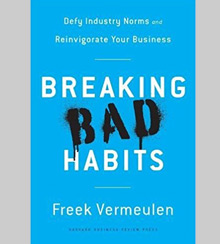 Back in the day, reading the newspaper on my morning commute to Manhattan was an origami-like exercise in folding and refolding. I never wondered why newspapers were printed on broadsheets that were too big for the bus. But Freek Vermeulen did. The clumsily sized standard for newspapers of record peeved him.
Back in the day, reading the newspaper on my morning commute to Manhattan was an origami-like exercise in folding and refolding. I never wondered why newspapers were printed on broadsheets that were too big for the bus. But Freek Vermeulen did. The clumsily sized standard for newspapers of record peeved him.It took the associate professor of strategy and entrepreneurship at the London Business School years to ascertain that the widely used broadsheet dated back to 1712. That’s when the English government began taxing newspaper owners by the number of pages they printed. Bigger pages meant fewer pages and thus less tax. The tax was eventually abolished, but the broadsheet remained the standard — even though the cost of the paper was high and its unwieldy handling irritated readers such as Vermeulen.
In 2003, an English newspaper bucked the long-established standard. The struggling Independent ran an experiment. It offered its paper in broadsheet and in a format exactly half that size in one market. The smaller paper outsold the larger by three to one. The Independent’s leaders quickly adopted the half-size version nationwide, and the paper’s print circulation rose 20 percent annually for several years.
The lesson, says Vermeulen, and the worthy theme of his new book, Breaking Bad Habits: “Killing bad practices can open up new avenues of growth and innovation and reinvigorate your business.” Read the rest here.
Posted by
Theodore Kinni
at
8:00 AM
0
comments
![]()
Labels: bizbook review, corporate success, creativity, innovation, management, personal success, strategy+business
Sunday, November 26, 2017
Creating Positive Moments for Your Customers
strategy + business, November 22, 2017
by Theodore Kinni
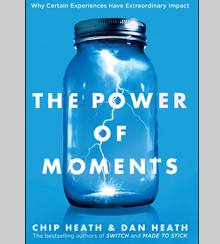 Quick question. Customers rank their interactions with your company on a scale of 1 (very negative) to 7 (very positive). Should you invest more resources in improving the experiences of customers who rank their interactions at a 1, 2, or 3, or those who rank them at a 4, 5, or 6?
Quick question. Customers rank their interactions with your company on a scale of 1 (very negative) to 7 (very positive). Should you invest more resources in improving the experiences of customers who rank their interactions at a 1, 2, or 3, or those who rank them at a 4, 5, or 6?
When brothers Chip and Dan Heath, a professor at Stanford Graduate School of Business and a senior fellow at Duke University’s CASE Center, respectively, asked executives how they invest their resources, the executives estimated that, on average, their companies spend 80 percent of their resources trying to improve the experiences of their unhappiest customers. Yet, report the Heaths, in 2016, when Forrester Research tabulated its annual U.S. Customer Experience Index and modeled the financial results in 16 industries, it discovered that “there’s nine times more to gain by elevating positive customers than by eliminating negative ones.”
This finding supports the main point in The Power of Moments, the latest in a series of formulaic but insightful books by the Heaths that seek to illuminate questions with important business ramifications, such as how to make ideas sticky and how to create change successfully. The point in this case is that “positive defining moments” can produce extraordinary effects in both individuals and organizations. The book explains how such moments are created. Read the rest here.
Posted by
Theodore Kinni
at
2:09 PM
0
comments
![]()
Labels: bizbook review, books, change management, corporate life, corporate success, customer experience, personal success, selling, strategy+business, work
Wednesday, November 8, 2017
The €1 trillion challenge in European banking
strategy&, November 8, 2017
Learned a lot lending an editorial hand on this whitepaper.
Download or read it here

Posted by
Theodore Kinni
at
1:55 PM
0
comments
![]()
Labels: corporate success, financial services, innovation, management
Wednesday, November 1, 2017
Four Ways Nonprofits Can Increase Their Impact
Insights by Stanford Business, November 1, 2017

The sector’s sheer heft — it’s larger than the banking and retailing industries — is one reason that Stanford GSB alumni and lecturers Bill Meehan and Kim Starkey Jonker wrote Engine of Impact: Essentials of Strategic Leadership in the Nonprofit Sector, which came out this November. Another is their conviction that the sector has entered a new era, which they’ve named the “Impact Era.”
The good news of the Impact Era is that, by 2025, philanthropists will likely contribute a record $500 billion to $600 billion annually to nonprofits, well above the $373 billion recorded in 2015. The bad news is the nonprofits will still come up short by $100 billion to $300 billion in the funding they require. “In brief, [nonprofits] will need more money, and lots of it,” according to Meehan and Jonker in the introduction to Engine of Impact.
Here, Meehan and Jonker discuss how nonprofits can make up the shortfall and meet the challenges of the Impact Era. Read the rest here.
Posted by
Theodore Kinni
at
6:11 PM
0
comments
![]()
Labels: books, Insights by Stanford Business, leadership, management, nonprofits
Wednesday, October 25, 2017
Do-It-Yourself Oceaneering
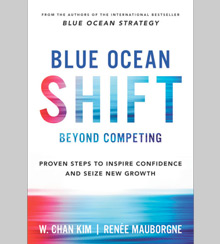 strategy + business, October 25, 2017
strategy + business, October 25, 2017
by Theodore Kinni
INSEAD professors W. Chan Kim and Renée Mauborgne hit the thought leadership lottery with the idea of blue oceans. Their 2005 book, Blue Ocean Strategy, Harvard Business School Press, which described the advantages of setting sail for new “blue ocean” markets devoid of competitors versus battling for percentage points of share in mature, commoditized “red ocean” markets, sold more than 3.5 million copies. The two professors, having found their own blue ocean, quickly ascended to the pinnacle of strategic consulting: INSEAD presented them with an institute and built blue ocean strategy into its MBA curriculum. Given all this success, the only truly surprising thing is that it took 12 years for Kim and Mauborgne to publish a follow-up.
For the most part, Blue Ocean Shift proves to be worth the wait. It is a practical, well-written guide to finding and exploiting blue ocean markets, informed by the experiences of companies and other organizations that have chosen to seek them out rather than compete toe-to-toe in established markets. Read the rest here.
Posted by
Theodore Kinni
at
9:09 AM
0
comments
![]()
Labels: bizbook review, books, change management, corporate success, decision making, entrepreneurship, innovation, personal success, strategy+business
Monday, October 16, 2017
Why Entrepreneurs Should Care Less About Disrupting and More About Creating
MIT Sloan Management Review, October 16, 2017
Posted by
Theodore Kinni
at
3:10 PM
0
comments
![]()
Labels: books, corporate success, entrepreneurship, leadership, personal success, work
Sunday, October 15, 2017
How to Keep More of What You Make
Learned a lot about how to shelter wealth in private businesses while lending an editorial hand here. Read the rest at https://lnkd.in/gEFvJpu
Posted by
Theodore Kinni
at
2:41 PM
0
comments
![]()
Labels: articles to ponder, corporate success, leadership, management, personal success
Wednesday, October 11, 2017
Take a Timeout, Leaders
 strategy+business, October 11, 2017
strategy+business, October 11, 2017by Theodore Kinni
On July 4, 1845, Henry David Thoreau went to the woods to live deliberately. After spending two years, two months, and two days in a 150-square-foot cabin that he built himself for $28.12 and a halfpenny, Thoreau had worked out the gist of the transcendentalist classic Walden; or, Life in the Woods. In it, he wrote, “I never found the companion that was as companionable as solitude.”
CEOs and other leaders would do well to get on companionable terms with solitude, too, according to first-time authors Raymond M. Kethledge, a U.S. Court of Appeals judge, and Michael S. Erwin, a leadership development consultant and assistant professor at West Point. Leaders don’t necessarily have to get off the grid and live in a hut for two years. But in Lead Yourself First, the authors make an extended argument that leaders should reserve some alone time “to find clarity, creativity, emotional balance, and moral courage.” They illustrate their thesis with numerous examples. Read the rest here.
Posted by
Theodore Kinni
at
10:25 AM
0
comments
![]()
Labels: bizbook review, books, corporate success, creativity, decision making, entrepreneurship, leadership, management, personal success, strategy+business
Tuesday, October 3, 2017
Three Career Tips for the Purposeless
In which, I vent my frustration with the fetishization of purpose...
LinkedIn Pulse, October 3, 2017

“I’m not here to give you the standard commencement about finding your purpose. We’re millennials. We’ll try to do that instinctively,” Mark Zuckerberg told Harvard’s Class of 2017. “The challenge for our generation is creating a world where everyone has a sense of purpose.”
Baloney. A sense of purpose is like an appendix. If you’ve got one, good for you. If you don’t, you’re not missing anything important.
I’ve always been purposeless. As a kid, I kinda worried about it. I thought I was missing something essential because all I wanted to be was a New Jersey Lottery winner. (In those days, the grand prize was a cool million. Pretax. Woo-hoo!)
But getting a purpose was never a burning issue for me. Getting a job was far more important. I needed money—mainly because the only thing my parents ever agreed on was that one kid wasn’t enough.
Sans purpose, it did take me a long time—15 years—to find work that worked for me. But I learned some lessons along the way. I offer them here as shortcuts to everyone else who drew a blank ticket in the purpose lottery. Read the rest here.
Posted by
Theodore Kinni
at
8:41 AM
0
comments
![]()
Labels: articles to ponder, corporate life, personal success, work
Tuesday, September 19, 2017
Moving Beyond the Silicon Valley State of Mind
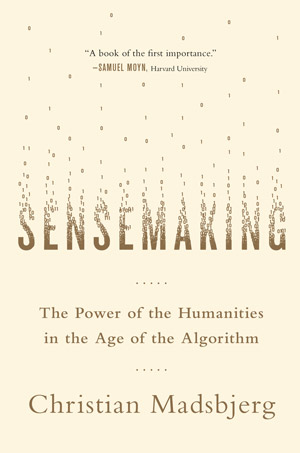 MIT Sloan Management Review, September 18, 2017
MIT Sloan Management Review, September 18, 2017by Theodore Kinni
To steal a phrase from Anton Chekhov, the great danger of the Age of the Algorithm is that we will know everything and understand nothing. In his new book Sensemaking, a polemic defending the need for the liberal arts in business, Christian Madsbjerg, a founder of strategic consulting company ReD Associates based in Copenhagen and New York, argues that leaders shouldn’t try to know everything. Instead, they should try to make sense of something.
Madsbjerg offers up sensemaking as the antidote to algorithmic thinking — “a Silicon Valley state of mind” that relies exclusively on data for direction. Relying on data alone is taking “a journey determined by the reductions of a GPS,” according to the author. Sensemaking is the North Star: It provides the essential context for data — the rationale for collecting it and the perspective needed to gain insight from it.
In the excerpt below, Madsbjerg tells the story of Napa Valley’s Cathy Corison, comparing her approach to wine making with the data-driven approach of Leo McCloskey, founder of Sonoma, California-based Enologix, Inc., to illustrate the difference between traveling by the North Star and the GPS. Read the excerpt here.
Posted by
Theodore Kinni
at
7:32 AM
0
comments
![]()
Labels: books, corporate success, education, entrepreneurship, leadership, management, personal success
Monday, September 18, 2017
Is Capitalism Killing America?
 Insights by Stanford Business, September 18, 2017
Insights by Stanford Business, September 18, 2017
by Theodore Kinni
On August 2, 2017, the Dow Jones Industrial Average hit a record-breaking 22,000 — its fourth 1,000-point advance in less than a year. That same day, I read the first sentence in Peter Georgescu's new book, Capitalists Arise! End Economic Inequality, Grow the Middle Class, Heal the Nation (Berrett-Koehler, 2017): “For the past four decades, capitalism has been slowly committing suicide.”
How does Georgescu, the chairman emeritus of Young & Rubicam (Y&R) and a 1963 graduate of Stanford Graduate School of Business, reconcile the Dow’s ascent with his gloomy assertion?
“The stock market has nothing to do with the economy per se,” he says. “It has everything to do with only one thing: how much profit companies can squeeze out of the current crop of flowers in the garden. Pardon the metaphor. But that’s what corporations do — they squeeze out profits.”
In the latter half of the 1990s, Georgescu shepherded Y&R through a global expansion and an IPO. He has served on the boards of eight public companies, including Levi Strauss, Toys “R” Us, and International Flavors & Fragrances. He also is the author of two previous books, The Constant Choice: An Everyday Journey from Evil Toward Good (Greenleaf, 2013) and The Source of Success (Jossey-Bass, 2005). An Advertising Hall of Fame inductee, the 78-year-old adman is still pitching corporate leaders. Now, however, he is trying to convince them to fundamentally rethink how — and for whom — they run their companies. Read the rest here.
Posted by
Theodore Kinni
at
3:54 PM
0
comments
![]()
Labels: books, business history, corporate success, economic history, economics, Insights by Stanford Business, leadership, regulation
Friday, September 15, 2017
Why Airbnb will always be a better business than Uber
Learned a lot about the nuances of platforms while editing this one by Jonathan Knee of Columbia Business School
MIT Sloan Management Review, Sept. 15, 2017
by Jonathan A. Knee
 The dramatic influence of the internet on how businesses operate and the emergence of a handful of gigantic, digitally enabled corporations have led to breathless pronouncements regarding the importance of a peculiar new class of monopolies built on digital platforms. These platforms, it is argued, fuel network effects that lead inexorably to winner-take-all marketplaces. This perspective is invariably coupled with infectious optimism and investment euphoria regarding the extraordinary scale and strength of network-effects businesses.
The dramatic influence of the internet on how businesses operate and the emergence of a handful of gigantic, digitally enabled corporations have led to breathless pronouncements regarding the importance of a peculiar new class of monopolies built on digital platforms. These platforms, it is argued, fuel network effects that lead inexorably to winner-take-all marketplaces. This perspective is invariably coupled with infectious optimism and investment euphoria regarding the extraordinary scale and strength of network-effects businesses.In theory, the key attribute of a network-effects business is its momentum-driven flywheel. Every new participant increases the value of the network to existing participants, attracts more new users, and makes the prospect of a successful competitive attack ever more remote — thereby bolstering the relative attractiveness of the business. The imagined innate indomitability of network effects stems at least in part from the breathtaking strength of notable platform businesses, like Facebook’s social network or Microsoft’s Windows operating system.
The problem is that not all platform businesses exhibit network effects. Moreover, even a cursory survey of the landscape does not support the oft-repeated assertion that such effects are “likely to strengthen a market’s winner-take-all tendency.” For every Facebook and Microsoft, there are literally hundreds of network-effects businesses operating in crowded sectors or in sectors where it is not clear that anyone will ever turn a profit. Take, for example, the once hot peer-to-peer lending space, which after more than a decade has attracted dozens of aspiring entrepreneurs and spawned a billion-dollar IPO but nevertheless has largely been a bust. The first mover in U.S. P2P lending, San Francisco-based Prosper Marketplace Inc., continues to struggle to achieve consistent profitability, and the billion-dollar IPO of San Francisco-based Lendingclub Corp. quickly ended in tears for investors.
Nor are digital platforms necessarily better businesses than the analog versions that they displace. Analog malls had the benefit of their shoppers being many miles away from competing malls, and the benefit of their retail tenants being committed to long-term leases. On the internet, platform competitors are only a click away and companies regularly and dynamically optimize their customer reach across competing platforms and directly via their own sites.
It is not that marketplace businesses built on e-commerce platforms do not have advantages or that they cannot thrive. Rather, it is that the mere existence of network effects tells entrepreneurs and investors relatively little about the attractiveness of a particular business. For example, there is almost no fundamental difference in the network effects enjoyed by Uber Technologies Inc. and Airbnb Inc., the global leaders in the ride-hailing and short-term lodging marketplaces, respectively. Yet, other characteristics of those industries ensure that Airbnb will enjoy dramatically stronger results than Uber will ever achieve. Read the rest here.
Posted by
Theodore Kinni
at
2:17 PM
0
comments
![]()
Labels: articles to ponder, competitive intelligence, corporate success, digitization, innovation, marketing, technology
Tuesday, September 5, 2017
Why First Impressions Are Often Wrong
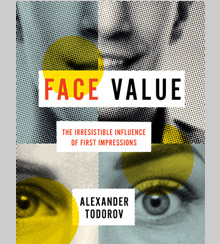
strategy+business, September 5, 2017
by Theodore Kinni
The list of human foibles is long. The 2015 s+b article “Beyond Bias” lists 24 of the most common biases, including blind spots, the illusion of control, and the concept of sunk costs. Since the early 2000s, Princeton University psychology professor Alexander Todorov has been studying one of those long-standing human foibles: the first impression.
In his new book, Face Value, Todorov pulls together all he’s learned about first impressions. At first glance — and upon a careful reading — it makes for a fascinating and thorough examination of the subject. Todorov’s expansive tour includes the history of physiognomy (the dubious science of predicting character from physical appearance) and a survey of modern first-impression research, much of which Todorov has conducted in his Social Perceptions Lab at Princeton. His conclusion: We find judging others based on a single glance irresistible, but the judgments we reach are usually wrong. Read the rest here.
Posted by
Theodore Kinni
at
9:53 AM
0
comments
![]()
Labels: bizbook review, books, corporate life, corporate success, decision making, human resources, leadership, management, personal success, strategy+business
Thursday, August 3, 2017
Blockchain is poised to disrupt trade finance
Learned a lot lending an editorial hand here:
PwC Next in Tech blog, August 3, 2017
by Grainne McNamara
Trade finance has enabled the exchange of goods for millennia. Babylonian cuneiform tablets dating back to 3000 BC mention the kind of promissory notes and letters of credit that still underpin international trade. And, aside from incremental improvements in the ways and means of trade finance, not all that much has changed in the fundamental elements of this approximately US$40 billion sector of the financial services industry over the past 5,000 years.
That is, until now. The advent of blockchain technology is on the verge of revolutionizing trade finance—and it threatens to leave behind any financial services company that doesn’t move with the times. Read the rest here.
Posted by
Theodore Kinni
at
6:06 PM
0
comments
![]()
Labels: articles to ponder, blockchain, corporate success, economic history, financial services, technology
Wednesday, August 2, 2017
A Goldilocks Approach to Innovation
by Theodore Kinni
In 2008, when Nike executive Sarah Robb O’Hagan was tapped to lead Gatorade, the sports drink’s sales were in decline and it was losing market share to its principal rival, Powerade. She couldn’t turn to incremental innovation: Pursuing the tried-and-tested strategy of adding flavors and low-calorie options to the Gatorade portfolio had already run its course, and was not yielding returns. The idea of blowing up one of PepsiCo’s billion-dollar brands and the organization behind it in a bid for radical reinvention was too risky.
What did Robb O’Hagan do? Taking a page from Nike’s playbook, she refocused the company’s attention — and more meaningfully, its product development and marketing budgets — on Gatorade’s core customers: the serious athletes, young and old, who accounted for 46 percent of sales. Then, she began introducing new hydration and nutrition products designed particularly for that core group. Gatorade introduced a series of gels, bars, and protein shakes that complemented the sports drink and drove its sales, instead of cannibalizing demand for it.
“The innovations were diverse, targeted a specific set of customers, and posed little strategic risk,” writes Wharton School professor of practice David Robertson, author, with Kent Lineback, of The Power of Little Ideas. The new products also reversed Gatorade’s sales slide. By 2015, Gatorade, with sales of US$5.6 billion, owned 78 percent of the U.S. market for sports drinks, about four times Powerade’s 19 percent share. Read the rest here.
Posted by
Theodore Kinni
at
4:00 PM
0
comments
![]()
Labels: bizbook review, business history, corporate success, creativity, entrepreneurship, innovation, leadership, management, strategy+business
Saturday, July 29, 2017
Self-Publishing or Trade Publishing: Which is Best for Your Business Book?
LinkedIn, July 29, 2017
by Theodore Kinni
As a business writer and editor, I talk to lots of people who want a business book with their name on it. CEOs and other senior executives who are transitioning to new careers. Consultants who are establishing thought leadership platforms. Entrepreneurs who are building businesses. Speakers who want bigger audiences and something to sell at the back of the room. At some point or another, they all ask me the same question: Should I self-publish my book or find a publisher?
There is no pat answer. It depends on the book and what you want to achieve with it. But here are the three questions to ask to figure out the right answer for you. Read the rest here.
Posted by
Theodore Kinni
at
4:38 PM
0
comments
![]()
Labels: books, corporate success, entrepreneurship, ghostwriting, personal success, publishing, writing
Wednesday, July 19, 2017
Moving Sales With Trajectory-Based Mobile Advertising
MIT Sloan Management Review, July 19, 2017
by Theodore Kinni
Given the fast rise of mobile, it’s no surprise that marketers are well aware of it as a sales channel. But mobile isn’t just a new channel for reaching consumers with the same old offers. It provides marketers with valuable new sources of information about consumers, and it enables them to deliver new kinds of offers.
Anindya Ghose, Heinz Riehl Chair Professor of Business at New York University’s Stern School of Business, is one of the pioneering explorers of the intersection of mobile and marketing. In his new book, Tap: Unlocking the Mobile Economy (MIT Press, 2017), he collects his findings and weaves them together into a set of nine forces that marketers can wield to drive sales via mobile technologies.
One of the forces that Ghose explores is trajectory. “In the online world, it took us only a few years to get accustomed to, and often even embrace, the idea that firms — including e-commerce firms, search engines, and website publishers — can track our browsing behavior and predict our next steps,” he explains. “A similar revolution is about to hit us off-line. The springboard for this revolutionary leap is the individual’s trajectory. An individual’s trajectory is the physical and behavioral trace of his or her off-line movements.”
Mobile devices allow marketers to track a consumer’s walking pattern and predict where he or she will go next. Moreover, they can create and deliver offers based on that trajectory. In the following excerpt, Ghose describes what he and his colleagues learned when they used trajectory-based advertising in one of Asia’s largest shopping malls. Read the excerpt here.
Posted by
Theodore Kinni
at
2:20 PM
0
comments
![]()
Labels: analytics, books, corporate success, marketing, mobile, technology
Smart Leaders Know the Difference Between Complex and Complicated. Do You?
Inc., July 19, 2017
by Theodore Kinni
You probably use the words 'complex' and 'complicated' interchangeably. Most of us do. Heck, most dictionaries use complex to define complicated and vice versa. There's just one problem: If you're a leader and you treat a complex problem like a complicated problem, you are setting up yourself and your company for failure.
If that sounds like baloney to you, it might be worth taking a look at Rick Nason's eye-opening new book, It's Not Complicated: The Art and Science of Complexity in Business (University of Toronto Press, May 2017). In it, Nason, a finance professor at Dalhousie University's Rowe School of Business, makes a compelling case that understanding the difference between complicated and complex is an imperative for highly effective executives.
Leaders, says Nason, tend not to realize that complicated issues are different than complex ones. Thus, they try to address them both in the same way. Want to guess what happens next?
You already know the answer. It's what happens when you try to treat employees as if they were interchangeable robots or when you try to remove a passenger with a ticket from your airplane or when you merge two companies with very different cultures together. The situation deteriorates really fast. Read the rest here.
Posted by
Theodore Kinni
at
8:39 AM
0
comments
![]()
Labels: books, change management, corporate success, decision making, leadership, management, personal success
The Sore Loser and the Supercomputer
strategy+business, July 19, 2017
by Theodore Kinni
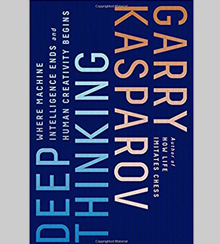 In June 1985, Garry Kasparov, the highest-ranked chess player in the world, simultaneously played 32 games against 32 computers. He swept the event, winning every game. Twelve years later, in May 1997, Kasparov played a high-stakes, head-to-hard-drive, six-game match against a single computer: IBM’s Deep Blue. The result? The supercomputer beat the reigning chess champ in regulation play. Artificial intelligence had hit the big time.
In June 1985, Garry Kasparov, the highest-ranked chess player in the world, simultaneously played 32 games against 32 computers. He swept the event, winning every game. Twelve years later, in May 1997, Kasparov played a high-stakes, head-to-hard-drive, six-game match against a single computer: IBM’s Deep Blue. The result? The supercomputer beat the reigning chess champ in regulation play. Artificial intelligence had hit the big time.It’s taken Kasparov a long time to process his historic battle against Deep Blue. “I’m a sore loser,” he frankly admits in Deep Thinking, which is a meditation on both his personal history and the future of work. A full 20 years later, that characteristic is evident in Kasparov’s description and analysis of the match — and his detailed suspicions about spying and “human intervention” by IBM.
Kasparov clearly didn’t expect Big Blue, led in those days by Louis Gerstner Jr., to play to win. The company invested an estimated US$20 million in developing and promoting Deep Blue, and the win, Kasparov argues, boosted IBM’s stock by $11.4 billion in just over a week — to say nothing of the value that accrued to the brand. Nevertheless, Kasparov appears surprised that IBM treated the match as anything other than a collegial experiment in computer science (even though he had negotiated a guaranteed minimum payday of $400,000 in case of a loss; the Deep Blue development team received $700,000).
Unless you are a serious chess player, however, Kasparov’s account of the match isn’t the best reason to read Deep Thinking. Read the rest here.
Posted by
Theodore Kinni
at
8:32 AM
0
comments
![]()
Labels: bizbook review, books, corporate success, data science, decision making, personal success, strategy+business, technology, work
Tuesday, July 18, 2017
Sheryl Sandberg: Develop Your Voice, Not Your Brand
Insights by Stanford Business, July 18, 2017
by Theodore Kinni
Today Sheryl Sandberg is known as a leading Silicon Valley executive and a champion of working women. But when she arrived in California in 2001, after a five-year stint at the U.S. Treasury, she wasn’t exactly welcomed with open arms.
“All the exciting stuff was happening out here, so I wanted to work in Silicon Valley,” recalls Sandberg. “Lots of people said ‘I would never hire anyone like you’ to my face. The first tech bubble had just burst. It was actually hard to get a job.”
But Sandberg did get a job — and an impressive one. She served as Google’s vice president of global online sales and operations until 2008, when Facebook founder Mark Zuckerberg convinced her to join the social networking site as its COO.
In 2013, Sandberg became a best-selling author with the publication of Lean In: Women, Work, and the Will to Lead. Since then, its readers have founded 33,000 Lean In peer support circles in 150 countries.
Sandberg’s life seemed charmed until May 2015, when her husband and the father of her two children, Dave Goldberg, died suddenly. “When Dave died, I didn’t think I was capable of anything. I could barely go to work and not cry. I was parenting two grieving children,” she says.
Sandberg channeled her own grief into a second book, Option B: Facing Adversity, Building Resilience, and Finding Joy. Co-authored with Wharton School professor Adam Grant, it, too, has found a global readership and, with the support of the Sheryl Sandberg & Dave Goldberg Family Foundation, has already attracted a community of 350,000 people.
On May 25, Sandberg described her journey and the lessons she has learned along the way to Stanford Graduate School of Business students at the final View From The Top event of the 2016-17 academic year. Read the rest here.
Posted by
Theodore Kinni
at
11:47 AM
0
comments
![]()
Labels: books, corporate success, Insights by Stanford Business, leadership, management, personal success, work
Monday, July 17, 2017
Want to Be a Better Decision Maker? Here Are 3 Timeless Guidelines for Leaders
Inc., July 17, 2017
by Theodore Kinni
Before McKinsey & Company senior partners Scott Keller and Mary Meaney decided what to include in their new book about organizational leadership, they grouped all of the leadership-related articles published by Harvard Business Review from 1976-2016 into 20 topics--culture, change, self-improvement, managing others, etc. Then, they analyzed how the number of articles written on those topics varied over time as a percent of all HBR articles.
"Our logic was that the lower the variance over forty years, the more timeless the topic," write Keller and Meaney in their introduction to Leading Organizations: Ten Timeless Truths (Bloomsbury, June 2017). The most timeless topic of all? Decision-making.
This didn't particularly surprise the consultants. They calculate that there are roughly 400 million decisions made every day in the average Fortune 500 company. Of course, the vast majority of those decisions are inconsequential, but a select few of them could be very consequential indeed.
Like, say, Time Warner CEO Gerald Levin's decision to merge with AOL back in 2000--on the eve of the dotcom meltdown. In 2003, the merged company posted a $99 billion loss on what is still widely hailed as the worst deal ever. The flamboyant Ted Turner, who was Time Warner's largest shareholder before the deal and lost about $8 billion personally, likened it to the Vietnam War on his personal disaster scale.
To avoid disasters like this and hone your decision-making process and prowess, Keller and Meaney offer the following advice: Read the rest here.
Posted by
Theodore Kinni
at
7:18 AM
0
comments
![]()
Labels: books, change management, corporate success, decision making, entrepreneurship, leadership, management, personal success
Friday, July 14, 2017
Want to Be a Better Salesperson? Start Practicing This 1 Crucial Skill
Inc., July 14, 2017

Posted by
Theodore Kinni
at
5:15 PM
0
comments
![]()
Labels: books, corporate success, personal success, sales
Monday, July 10, 2017
What a Bestselling Author Knows About the True Genius of Steve Jobs and Ben Franklin
Inc., July 10, 2017
by Theodore Kinni

In May, Walter Isaacson, CEO of the Aspen Institute and former chairman and CEO of CNN, came to my hometown to deliver the commencement address and pick up an honorary degree at The College of William & Mary. You probably know him for his best-selling biographies, including Steve Jobs (Simon & Schuster, 2011) and Benjamin Franklin: An American Life (Simon & Schuster, 2003).
Given Isaacson's obvious interest in the personality traits, innovative thinking, and entrepreneurial flair of geniuses, I expected his address to celebrate mavericks or, as Apple put it in the memorable "Think Different" ad campaign, "the crazy ones." But he threw a changeup.
"We taught you here to be individual achievers. We celebrated individual achievement and even singular visionaries," Isaacson told William & Mary's graduating class of 2017. "What we forgot to tell you is that in the real world it's not about singular achievement. It's about teamwork. It's about being able to collaborate. When you get to the real world, you are going to learn that innovation is a team sport and that success is a collaborative effort." Read the rest here.
Posted by
Theodore Kinni
at
8:32 AM
0
comments
![]()
Labels: books, business history, corporate success, entrepreneurship, innovation, leadership, management, personal success
Wednesday, July 5, 2017
'Hit 'em Where They Ain't!' and Two More Lessons in Strategy From General Douglas MacArthur
Inc., July 5, 2017
by Theodore Kinni

Seventy-two years ago today, on July 5, 1945, General Douglas MacArthur officially announced the liberation of the Philippines. It was a triumphal moment for the 5-star general. It marked the ultimate fulfillment of his memorable promise ("I shall return"), and it brought the war in the Pacific to Japan's doorstep.
MacArthur was one of the world's most admired leaders in those days, and although the Chinese and President Harry Truman would tarnish his shining reputation in the 1950s, MacArthur's strategic creativity, agility, and focus in World War II's Pacific Theater remain a high point in military history. They also offer valuable lessons to founders who are searching for innovative ways to gain a foothold in highly competitive markets populated by stronger, more established players.
Here are three of those lessons, drawn from No Substitute for Victory: Lessons in Strategy and Leadership from General Douglas MacArthur. Read the rest here.
Posted by
Theodore Kinni
at
8:39 AM
0
comments
![]()
Labels: books, corporate success, creativity, leadership, personal success, strategy
Monday, July 3, 2017
Spend Your Weekend Like Shonda Rhimes (Studies Prove It Will Boost Your Productivity)
Inc., July 1, 2017
by Theodore Kinni
"You can work long, hard or smart, but at Amazon.com, you can't choose two out of three," asserted Jeff Bezos in his 1997 letter to shareholders. Journalist Katrina Onstad strenuously disagrees: "Actually, you should choose: the last two. The first one is bullshit."
Onstad makes that case in her new book, The Weekend Effect: The Life-Changing Benefits of Taking Time off and Challenging the Cult of Overwork (HarperOne, May 2017). In it, she cites studies stretching back to the early 1900s that prove that our productivity and effectiveness decline when we consistently exceed 40-hour work weeks. This should give pause to entrepreneurs who think they--and their employees--have to work long hours to succeed.
In fact, Onstad calls out some highly successful founders whose work ethic might give Jeff Bezos pause--like TV producer and showrunner Shonda Rhimes. Rhimes gets as many as 2,500 emails daily, but she won't read or respond to them after 7:00 pm on weeknights or on weekends. "Work will happen twenty-four hours a day, 365 days a year if you let it," Rhimes told NPR. "It suddenly occurred to me that unless I just say, 'That's not going to happen,' it was always going to happen."
I interviewed Onstad (on a Wednesday during working hours) to learn more about The Weekend Effect and why and how we should reclaim our weekends. Read the rest here.
Posted by
Theodore Kinni
at
8:40 AM
0
comments
![]()
Labels: books, business history, corporate success, creativity, entrepreneurship, human resources, management, org culture, personal success, work
Saturday, July 1, 2017
Ethics Should Precede Action in Machine Intelligence
MIT Sloan Management Review, June 29, 2017
by Theodore Kinni
As analytics and Big Data continue to be integrated into organizational ways and means from the C-suite to the front lines, Josh Sullivan and Angela Zutavern believe that a new kind of company will emerge. They call it the “mathematical corporation” — a mash-up of technology and human ingenuity in which machines delve into every aspect of a business in previously impossible ways and produce insights that will allow previously unimaginable solutions — new businesses, strategies, products and services, and so on.
Sullivan and Zutavern don’t think the mature mathematical corporation exists yet, but they do have a privileged view of the forces that will produce it. Both are executives at Booz Allen Hamilton Inc., where Sullivan organized and leads the company’s data science and advanced analytics capabilities, and Zutavern is developing applications of machine intelligence to organizational leadership and strategy.
In their new book, The Mathematical Corporation, Sullivan and Zutavern explore how company leaders can prepare for and accelerate the transformation to a new corporate model. The following excerpt from Chapter 7, edited for space, examines the inevitable ethical conflicts that will arise — and have already arisen — as the ability of companies to collect and parse personal data explodes. And more important, it points out the need to proactively anticipate those conflicts. Read the excerpt here.
Posted by
Theodore Kinni
at
8:05 AM
0
comments
![]()
Labels: AI, analytics, books, corporate success, ethics, technology
Monday, June 26, 2017
This Treasure Map Launched Disney's $17 Billion Theme Park Business
Inc., June 26, 2017
by Theodore Kinni

On Sunday, June 25, a map of Disneyland sold for $708,000, the highest price ever paid at auction for a piece of Disney memorabilia. It's worth every penny. This is the map that Walt Disney and his brother Roy used to raise the financing needed to build Disneyland. This map launched the parks and resorts business that swelled the coffers of the Walt Disney Company by $17 billion in fiscal 2016.
The map was drawn in September 1953, over a single weekend. As Disney Legend Herb Ryman later recalled, Walt called him on a Saturday morning and asked him to come to the studio. When Herb arrived, Walt explained that he needed $17 million to build Disneyland.
"Gee, that's a lot of money," said Herb. "What's the park going to be like?"
"It's going to have a lot of rides and it's going to have a train," said Walt. "It's going to have a lot of things, a whole lot of things. A lot of people. Very exciting. Roy has got to take a drawing with him on Monday morning to show the bankers. You know the bankers don't have any imagination."
"Well, where are the drawings?" asked Herb. "I'd like to see them."
"Oh, you're going to make them," said Walt. Read the rest here
Posted by
Theodore Kinni
at
7:49 AM
0
comments
![]()
Labels: books, business history, corporate success, creativity, entrepreneurship, innovation, leadership
Thursday, June 22, 2017
The Critical Difference Between Complex and Complicated
MIT Sloan Management Review, June 21, 2017
by Theodore Kinni
It’s time to call out the real culprit in far too many business failures — Dr. Peter Mark Roget and his insidious thesaurus. Roget is long dead, but his gang of modern-day editors still assert that the words “complex” and “complicated” are synonyms. Unfortunately, as Rick Nason, an associate professor of finance at Dalhousie University’s Rowe School of Business, ably explains in his new book, It’s Not Complicated, if you manage complex things as if they are merely complicated, you’re likely to be setting your company up for failure.
Complicated problems can be hard to solve, but they are addressable with rules and recipes, like the algorithms that place ads on your Twitter feed. They also can be resolved with systems and processes, like the hierarchical structure that most companies use to command and control employees.
The solutions to complicated problems don’t work as well with complex problems, however. Complex problems involve too many unknowns and too many interrelated factors to reduce to rules and processes. A technological disruption like blockchain is a complex problem. A competitor with an innovative business model — an Uber or an Airbnb — is a complex problem. There’s no algorithm that will tell you how to respond.
This could be dismissed as an exercise in semantics, except for one thing: When facing a problem, says Nason, managers tend to automatically default to complicated thinking. Instead, they should be “consciously managing complexity.” In the excerpt that follows, which is edited for space, Nason explains how. Read the rest here.
Posted by
Theodore Kinni
at
10:37 AM
0
comments
![]()
Labels: books, change management, corporate success, leadership, management, personal success
Tuesday, June 20, 2017
There's One Question You Must Ask Before Solving Any Problem (It's Also the Most Underrated Management Skill)
Inc., May 20, 2017
by Theodore Kinni

It's often said that most business books would make better articles, but there's an article in Sloan Management Review that turns the truism on its head. The article, titled 'The Most Underrated Skill in Management,' would make a great book. What is this skill? It's the ability to formulate a problem statement.
"There are few questions in business more powerful than 'What problem are you trying to solve?'" write authors Nelson P. Repenning, Don Kieffer, and Todd Astor. "In our experience, leaders who can formulate clear problem statements get more done with less effort and move more rapidly than their less-focused counterparts. Clear problem statements can unlock the energy and innovation that lies within those who do the core work of your organization."
To learn more about this most underrated skill, I interviewed Nelson Repenning, MIT Sloan School of Management Distinguished Professor of Systems Dynamics and Organizational Studies and chief social scientist at ShiftGear Work Design. Read the rest here.
Posted by
Theodore Kinni
at
9:18 AM
0
comments
![]()
Labels: articles to ponder, corporate life, corporate success, entrepreneurship, innovation, management, personal success
Wednesday, June 14, 2017
Love Her or Hate Her, Ayn Rand Can Make You a Better Leader
Inc., June 14, 2017
by Theodore Kinni

Ayn Rand is one of the most polarizing figures in American culture--and she's been dead for 35 years. People either love or hate the author of Atlas Shrugged and The Fountainhead. And when I co-authored Ayn Rand and Business about how Rand's philosophy of Objectivism applies to management, I got caught in the crossfire.
The Rand haters rejected the book because they think Rand is a heartless monster. And when Rand lovers discovered that I didn't think she had lived up to her own philosophical tenets, they rejected the book as a back-handed attack on Objectivism. Both camps ignored the actual thesis of the book--that Rand's Objectivism is a terrific philosophy for management. It can make you a better leader, enhance your ability to innovate, and intensive your focus on building a successful business.
Evidence for this can be found in Rand's seven Objectivist virtues. These virtues are behaviors that Rand said we all need to cultivate to succeed in life. When you apply them to business, they provide a guide for getting the most value out of your work. Read the rest here.
Posted by
Theodore Kinni
at
8:09 AM
0
comments
![]()
Labels: books, corporate success, entrepreneurship, personal success
Monday, June 12, 2017
One Doctor’s Take on How to Fix the Sick Healthcare System
strategy+business, June 12, 2017
by Theodore Kinni
A decade after presidential candidate Barack Obama first declared comprehensive healthcare reform a central tenet of his platform — and seven decades after President Harry S. Truman proposed a national healthcare plan — the issue still stands at the center of political debate. In 2017, a Republican-dominated Congress and a new Republican president are grappling with their own comprehensive plan.
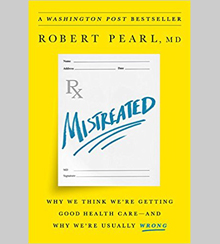 But even if the Affordable Care Act is repealed and replaced, Dr. Robert Pearl believes U.S. consumers and companies are unlikely to get any relief from rising costs. That’s what Pearl argues in his no-holds-barred book, Mistreated. This line of argument is dismaying and more than a little surprising, especially considering that Pearl isn’t an academic, or an activist, or a pundit with a shallow outsider’s knowledge of the industry. For nearly 20 years, until this month, he was the CEO of the Permanente Medical Group, which is a subsidiary of California-based managed-care giant Kaiser Permanente as well as the largest provider network in the nation in its own right, with more than 9,000 physicians and 34,000 staff members. In other words, he’s one of the people who manage a significant chunk of our increasingly unaffordable medical care.
But even if the Affordable Care Act is repealed and replaced, Dr. Robert Pearl believes U.S. consumers and companies are unlikely to get any relief from rising costs. That’s what Pearl argues in his no-holds-barred book, Mistreated. This line of argument is dismaying and more than a little surprising, especially considering that Pearl isn’t an academic, or an activist, or a pundit with a shallow outsider’s knowledge of the industry. For nearly 20 years, until this month, he was the CEO of the Permanente Medical Group, which is a subsidiary of California-based managed-care giant Kaiser Permanente as well as the largest provider network in the nation in its own right, with more than 9,000 physicians and 34,000 staff members. In other words, he’s one of the people who manage a significant chunk of our increasingly unaffordable medical care.
Posted by
Theodore Kinni
at
7:39 AM
0
comments
![]()
Labels: bizbook review, healthcare, innovation, management, strategy+business
Thursday, June 8, 2017
The Greatest Business Failure Of All Time Produced One of The Best-Selling Books Ever
Inc., May 8, 2017
by Theodore Kinni

On June 8, the original manuscript of one of the best-selling books of all time was supposed to have been sold at auction. Valued at $2-3 million, it's title is Alcoholics Anonymous, but it's better known as the Big Book and, for nearly 80 years, it's been helping alcoholics in their struggle to get and stay sober.
In late May, Alcoholics Anonymous sued to stop the sale, claiming it was the rightful owner of the manuscript. But that's hardly the most interesting part of this story. What you probably don't know about the Big Book is that it played an integral role in the greatest business failure of all time.
In 1937, Alcoholics Anonymous co-founders Bill Wilson and Dr. Bob Smith discussed publishing a book to raise awareness about alcoholism, to help promote their program for combating the disease, and to attract investors for a for-profit chain of detox centers.
Recovering alcoholics themselves, Bill W. and Dr. Bob, as they are known, almost got the business off the ground. Read the rest here
Posted by
Theodore Kinni
at
8:31 AM
0
comments
![]()
Labels: books, corporate success, entrepreneurship, personal success, publishing
Tuesday, June 6, 2017
These Princeton Professors Found 4 Personality Types for Entrepreneurs. Which One Are You?
Inc., June 6, 2017
by Theodore Kinni
There are a lot of factors that contribute to the success--or failure--of a new business. But Chris Kuenne and John Danner, both of whom teach entrepreneurship at Princeton University's Keller Center, are convinced that one of them trumps all the rest.
"The personality of the leader or founder is the driving force in building any new business," they write in their new book, Built for Growth: How Builder Personality Shapes Your Business, Your Team, and Your Ability to Win (Harvard Business Review Press, June 2017).
That's good news, say the authors, "[because] unlike the other resources you need to successfully grow a business, personality is the one directly--and quintessentially--in your control." Of course, that begs a big question: Will any old personality do? After all, we've all got one.
Kuenne and Danner decided to find out. They adapted a personality-based clustering methodology used by marketers to parse the personalities of 450 entrepreneurs whose companies had achieved at least $3 million in annual revenue and had been in business for at least three years.
They studied the motivation and self-identity of these business builders, their decision-making and leadership styles, and their management approach. They found four distinct personalities of new business builders, which they label the Driver, Explorer, Crusader, and Captain. Read the rest here
Posted by
Theodore Kinni
at
7:30 AM
0
comments
![]()
Labels: bizbook review, books, corporate success, entrepreneurship, leadership, management, personal success
Thursday, June 1, 2017
Keith Richards Is a Surprisingly Good Leader. Here's His Number One Secret
Inc., June 1, 2017
by Theodore Kinni
One of them is the importance of focus and prioritization to a successful career. You might think that being the lead guitarist of the world's greatest bar band is all about sex, drugs, and rock n' roll. But the 550-page book makes it clear that rock n' roll always comes first for Richards. The fact that Richards takes his music seriously shouldn't be surprising. After all, you don't get paid a king's ransom for more than a half-century for doing your job unless you're damn good at it.
My favorite business lesson in Life comes in a throw-away paragraph early on. Read the rest here.
Posted by
Theodore Kinni
at
7:01 AM
0
comments
![]()
Labels: books, corporate success, entrepreneurship, leadership, management, personal success
Sunday, May 28, 2017
The 50-Year-Old Business Book You Need to Read (or Reread) Right Now
Inc., May 26, 2017
by Theodore Kinni
Drucker is as relevant today as he was in the latter half of the last century because he approached the study of business like a surgeon. His clarity of thought and language was like a scalpel, which he used to dissect every aspect of management until he had revealed its essence. In The Effective Executive, Drucker applied that scalpel to leadership.
Drucker was convinced that leaders are made, not born. He described five practices that can make you a more effective leader: read the rest here
Posted by
Theodore Kinni
at
7:37 AM
0
comments
![]()
Labels: books, business history, entrepreneurship, leadership, management, personal success
Wednesday, May 24, 2017
Cracking the Code of Economic Development
strategy+business, May 24, 2017
by Theodore Kinni
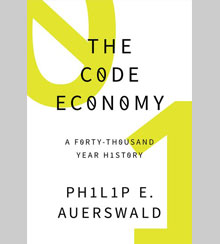
Philip E. Auerswald, associate professor at George Mason University’s Schar School of Policy and Government, calls this question “The Great Man–Machine Debate.” In his engaging and wide-ranging book, The Code Economy: A Forty-Thousand-Year History, he seeks to answer it by reframing how we think about economic dynamics and progress. “The microeconomics you learned in college was generally limited to the ‘what’ of production: what goes in and what comes out,” Auerswald writes. “This book is about the ‘how’: how inputs are combined to yield outputs.”
Auerswald has a more expansive definition of the word code than the typical computer scientist. For him, code encapsulates the how of production — that is, the technology and the instruction sets that guide production. The processes Paleolithic peoples used to create stone tools, the punch cards that Joseph Marie Jacquard used to direct looms in France in the early 1800s, Henry Ford’s assembly lines, and the blockchains first described by the person (or persons) named Satoshi Nakamoto in 2008: All these are, in Auerswald’s view, examples of code. Read the rest here.
Posted by
Theodore Kinni
at
8:32 AM
0
comments
![]()
Labels: bizbook review, business history, economic history, economic systems, economics, strategy+business, work
Sunday, May 21, 2017
The 3 Most Dangerous Work Personalities and How to Deal With Them
Inc., May 20, 2017
by Theodore Kinni
Since I don't have real job, I take special pleasure in reading about how bad having a real job can be. So, of course, I found it impossible to resist Jody Foster's The Schmuck in My Office: How to Deal Effectively with Difficult People at Work (with Michelle Joy, St. Martin's Press, April 2017). No, not that Jody Foster--Dr. Jody J. Foster, clinical professor of psychiatry at the Perelman School of Medicine at UPenn.
None of us are perfect, but Foster directs our attention to those select employees who really are schmucks--10 types of people whose personalities are so difficult and disruptive that they create chaos on the job, upset their coworkers, and drive their managers to distraction. Unfortunately, you'll recognize many of them. There's the Bean Counter, whose obsessive demands for the most minute details ensure that nothing meaningful ever gets done, and the Robotic, whose inability to connect with others on anything near a human level leaves people frostbitten and demotivated.
But even these knuckleheads are tolerable compared with the worst schmucks that Foster calls out in her book: Narcissus, The Venus Flytrap, and The Swindler. Here's how to recognize these three types and minimize the damage they can do to you and your company. Read the rest here.
Posted by
Theodore Kinni
at
10:35 AM
0
comments
![]()
Labels: books, corporate success, entrepreneurship, human resources, leadership, management, personal success, work
Wednesday, May 17, 2017
An Antidote for Health Care Reform Failure
Insights by Stanford Business, May 16, 2017
by Theodore Kinni

Posted by
Theodore Kinni
at
1:40 PM
0
comments
![]()
Labels: books, corporate life, government, healthcare, innovation, Insights by Stanford Business
